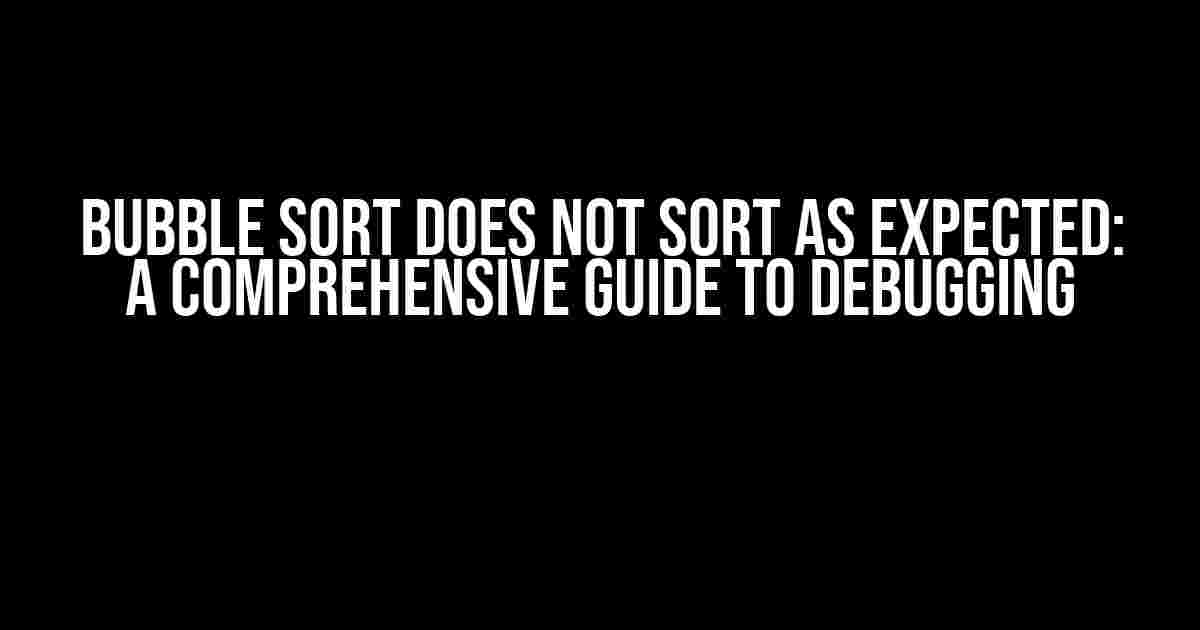Are you stuck with a Bubble sort algorithm that refuses to sort as expected? Do you find yourself scratching your head, wondering what went wrong? Well, wonder no more! In this comprehensive guide, we’ll dive into the world of Bubble sort, exploring common pitfalls, step-by-step debugging techniques, and optimization strategies to get your code running smoothly.
Understanding Bubble Sort
Bubble sort is a popular sorting algorithm that repeatedly steps through the list, compares adjacent elements, and swaps them if they are in the wrong order. The pass through the list is repeated until the list is sorted. Sounds simple, right? Yet, even the most seasoned developers can stumble upon unexpected results. But don’t worry, we’re here to help you identify and fix those pesky errors.
Common Issues with Bubble Sort
Before we dive into debugging, let’s take a look at some common issues that might be causing your Bubble sort to malfunction:
- Incorrect Looping Structure: Make sure you’re using the correct loop structure. A Bubble sort typically uses two nested loops: an outer loop that iterates through the list, and an inner loop that compares and swaps adjacent elements.
- Off-by-One Errors: Double-check your indexing. In most programming languages, arrays and lists are zero-indexed, which means the first element is at index 0, not 1.
- Swapping Issues: Ensure you’re swapping the correct elements. A common mistake is swapping the wrong variables or using the wrong indexing.
Step-by-Step Debugging Techniques
Now that we’ve covered common pitfalls, let’s walk through a step-by-step guide to debugging your Bubble sort algorithm:
- Print the List: Start by printing the original list to ensure it’s being passed correctly to your Bubble sort function.
- Use a Debugger: Set breakpoints and inspect variables at each iteration to see how the list is being modified.
- Verify Loop Invariants: Check that your outer and inner loops are functioning as expected. Ensure the outer loop iterates through the list correctly, and the inner loop compares and swaps adjacent elements.
- Test Small Lists: Try sorting small lists (e.g., 3-5 elements) to identify issues early on. This will help you pinpoint the problem area.
Example Code Walkthrough
Let’s take a look at an example Bubble sort implementation in JavaScript:
function bubbleSort(arr) {
let n = arr.length;
for (let i = 0; i < n - 1; i++) {
for (let j = 0; j < n - i - 1; j++) {
if (arr[j] > arr[j + 1]) {
// Swap arr[j] and arr[j + 1]
let temp = arr[j];
arr[j] = arr[j + 1];
arr[j + 1] = temp;
}
}
}
return arr;
}In this example, we’ll use the debugging techniques outlined above to identify and fix any issues:
| Step | Variable Values | Notes |
|---|---|---|
| 1. Print the List | arr = [5, 2, 8, 3, 1] | Original list printed correctly. |
| 2. Use a Debugger | i = 0, j = 0, arr = [5, 2, 8, 3, 1] | Debugger set, inspecting variables. |
| 3. Verify Loop Invariants | i = 0, j = 1, arr = [2, 5, 8, 3, 1] | Outer loop iterating correctly, inner loop comparing adjacent elements. |
| 4. Test Small Lists | arr = [3, 1, 2] | Sorting a small list to identify issues early on. |
Optimization Strategies
Once you’ve debugged your Bubble sort algorithm, it’s time to optimize it for better performance. Here are some strategies to keep in mind:
Flag Variable
Introduce a flag variable to track whether any swaps were made in the inner loop. If no swaps were made, the list is already sorted, and you can exit the algorithm early.
function bubbleSort(arr) {
let n = arr.length;
let swapped;
for (let i = 0; i < n - 1; i++) {
swapped = false;
for (let j = 0; j < n - i - 1; j++) {
if (arr[j] > arr[j + 1]) {
// Swap arr[j] and arr[j + 1]
let temp = arr[j];
arr[j] = arr[j + 1];
arr[j + 1] = temp;
swapped = true;
}
}
if (!swapped) break;
}
return arr;
}Coefficient of Comparison
Another optimization strategy is to reduce the number of comparisons made by the algorithm. One way to do this is by using a coefficient of comparison, which reduces the number of iterations required to sort the list.
function bubbleSort(arr) {
let n = arr.length;
let coefficient = 1.3; // Coefficient of comparison
for (let i = 0; i < n - 1; i++) {
for (let j = 0; j < Math.floor(n - i - 1 / coefficient); j++) {
if (arr[j] > arr[j + 1]) {
// Swap arr[j] and arr[j + 1]
let temp = arr[j];
arr[j] = arr[j + 1];
arr[j + 1] = temp;
}
}
}
return arr;
}Conclusion
With these debugging techniques and optimization strategies, you should be well-equipped to tackle even the most stubborn Bubble sort issues. Remember to take your time, carefully examine your code, and test thoroughly to ensure your algorithm is working as expected. Happy coding!
If you’re still struggling, feel free to share your code and we’ll be happy to help you debug and optimize it. Don’t let a pesky Bubble sort algorithm get the best of you!
Frequently Asked Question
Get the scoop on why bubble sort is acting up and how to fix it!
Why isn’t my bubble sort algorithm working as expected?
Ah-ha! This is probably because bubble sort depends on the correct implementation of comparisons and swaps. Make sure you’re iterating through the array correctly, and that your swap logic is on point. If you’re still stuck, try walking through your code step-by-step to identify where things are going awry!
My bubble sort is only partially sorting the array. What’s going on?
Hmm, that’s weird! This could be because your algorithm is stopping prematurely. Check if your outer loop is running enough times to fully sort the array. Also, ensure that your inner loop is properly iterating through the unsorted portion of the array. Give it another shot, and remember: patience is a virtue in coding!
I’ve implemented bubble sort, but it’s taking forever to sort large arrays. What can I do?
Yikes, performance issues are the worst! Bubble sort isn’t the most efficient sorting algorithm, especially for large datasets. Consider using a more efficient algorithm like quicksort or mergesort. If you’re stuck with bubble sort, try optimizing your implementation by reducing the number of swaps or using a flag to check if any swaps were made in a pass (if not, the array is already sorted!).
I’m using bubble sort for a specific problem, but it’s not stable. What does that even mean?
Ah, don’t worry, stability isn’t just for relationships! In the context of sorting, stability means that the order of equal elements is preserved. Bubble sort can be unstable because it may swap equal elements. If stability is crucial for your problem, consider using a stable sorting algorithm like insertion sort or merge sort instead.
Is bubble sort really that bad? Should I just avoid it altogether?
Well, bubble sort isn’t the worst, but it’s not the best either! While it’s simple to implement, its average and worst-case time complexity are O(n^2), making it less efficient than other algorithms. Unless you have a specific reason to use bubble sort, it’s generally better to choose a more efficient and scalable sorting algorithm. That being said, it’s still a great learning experience, so don’t be afraid to try it out and learn from it!


